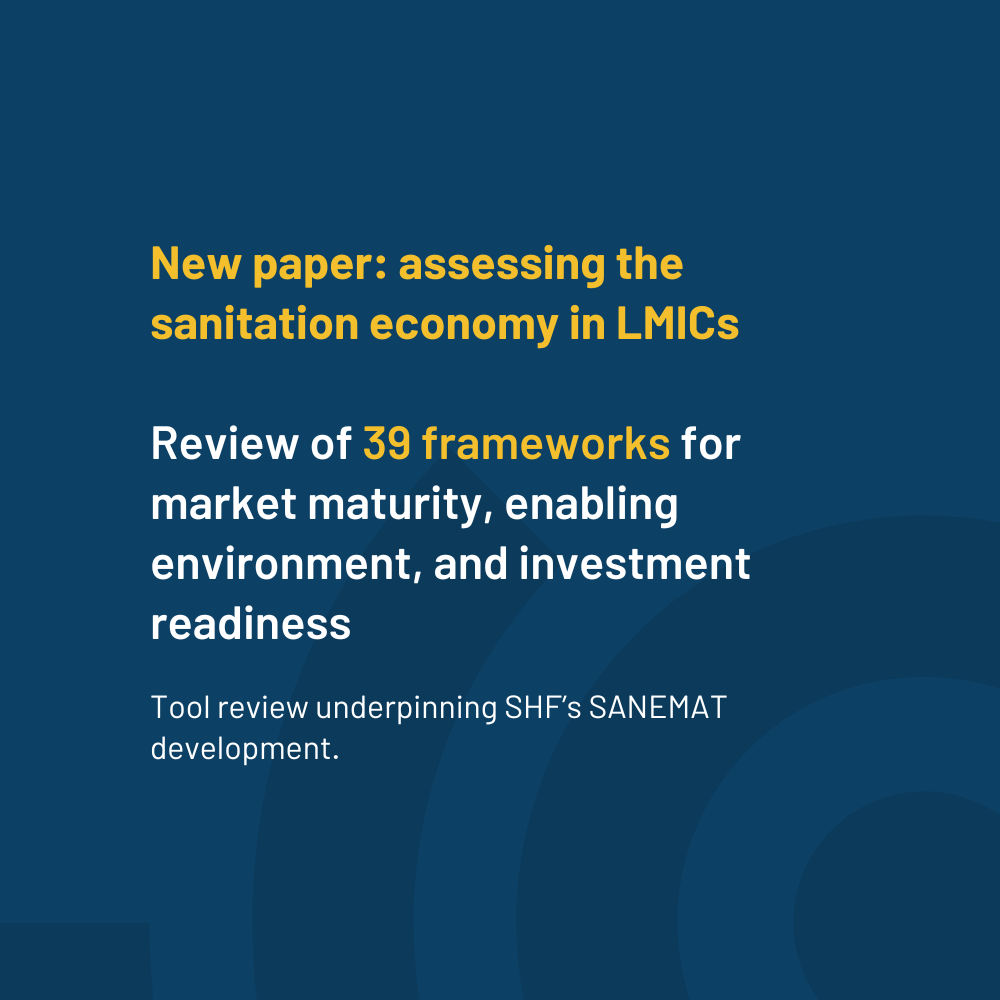
Measuring the Maturity of the Sanitation Economy: A Framework for Progress, a Roadmap for Investment

The growing recognition of the potential within local sanitation economies underscores the need for a comprehensive assessment framework that can guide both public and private sector investments, ultimately driving lasting impact.
Today, nearly half of the global population lacks access to safely managed sanitation. Bridging this gap is critical, as it affects health, economic growth, inclusion, and the environment. Achieving universal access will require a shift towards developing thriving sanitation markets where the public and private sectors can collaborate to provide operationally, financially, and environmentally sustainable solutions tailored to the unique needs of each community (learn more about Next Generation Sanitation).
The challenge remains: how can decision-makers best identify the pathways to unlock the full potential of local sanitation markets?
Understanding the sanitation market to unlock investments
The first step toward unlocking investment in sanitation is understanding the market itself. The market for sanitation goods and services in low- and middle-income countries (LMICs) is likely substantial but largely untapped. While governments in these countries face financial constraints in achieving the Sustainable Development Goals (SDGs), particularly SDG 6.2 on sanitation, there is a rising demand from households for improved services. Many are willing to pay for better solutions.
In fact, SHF estimates that sanitation economies in five African countries (Benin, Kenya, Nigeria, Sierra, Leone, Uganda) could be worth almost USD 19 billion by 2030 once universal access is achieved, unlocking growth, economic returns and social impact, especially for women and girls.
However, significant barriers hinder the development of sanitation economies in emerging markets. These include a lack of in-depth knowledge about the sector, which heightens perceived risks for investors and complicates effective policy and investment decisions.
A new, comprehensive framework to identify market-driven solutions
To overcome these challenges, SHF has been collaborating with key partners to explore existing frameworks for understanding sanitation economies and identify the gaps that need to be addressed for these economies to grow and thrive. The term ‘sanitation economy’ is broader than the sanitation market, as the sanitation economy encompasses the culture, values, technological opportunities, social organisation, political structure, legal systems, finances and policies which together are key factors in determining sanitation outcomes.
While several existing frameworks provide valuable insights into various aspects of the sanitation economy, none offer a complete picture of its maturity. Tools like the UN-Water Global Analysis and Assessment of Sanitation and Drinking-Water (GLAAS), the World Bank’s Service Delivery Assessments and UNICEF’s WASH Bottleneck Analysis Tool have contributed essential data over the past 15-20 years, helping steer investments toward improved sanitation outcomes at national level. Several tools developed by NGOs and Universities have also contributed valuably to strengthening the WASH enabling environment, especially at sub-national level. Other more recent tools have been developed, some with a greater focus on finances such as OECD’s Framework for assessing the enabling conditions to finance water security, and the Continental Africa Water Investment Programme - Programme for Infrastructure Development in Africa (AIP-PIDA) Water Investment Scorecard. However, according to SHF’s analysis, these frameworks, when considered individually or collectively, still leave gaps in understanding the full scope of the sanitation economy, particularly when it comes to investment opportunities and risks.
In a document published today, SHF has shared a first review of the existing frameworks assessing sanitation economy maturity, working with Dr. Guy Hutton and with input from over 50 organizations. The analysis (available here with annexes here) reveals that while our understanding of sanitation economies has evolved, no holistic assessment framework exists to provide a 360° view of the sanitation economy, nor to highlight opportunities and bottlenecks from policy, financing, and investor perspectives.
“In recent years, a variety of essential tools have emerged to assess sanitation economy maturity in specific countries or contexts, and across specific sector building blocks. As we aim to drive unprecedented investment into sanitation economies, we must build on these tools to create a framework that offers a comprehensive snapshot of local sanitation economies and markets, and identifies the steps required to unlock their full potential,” said Dr. Hutton.
Based on the findings of this review, SHF has developed the Sanitation Economy Maturity Assessment Tool (SANEMAT), which is being piloted and will be released later in 2025. This unique tool will provide governments, international donors, investors, and technical agencies with evidence about the status of sanitation economies in specific country contexts, while also identifying key investment opportunities.
“SHF’s mission has always been to transform how sanitation is viewed and funded. With the SANEMAT, countries and investors can visualize the vast potential within sanitation markets and take the necessary steps to unlock catalytic impacts on economies, the environment, and, most importantly, the lives of millions of people,” said Sue Coates, Deputy Executive Director, SHF.
Currently, SANEMAT is being piloted in Kenya and Uganda as part of SHF’s broader efforts in the countries.
SANEMAT builds on years of effort across the sector to realize a collective vision: thriving sanitation economies that deliver access to those in need while also creating jobs, businesses and impact for economies and the environment.



